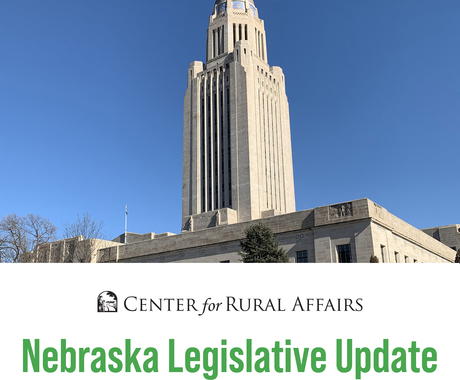By Jordan Rasmussen, former staff member
Note: On Sept. 8, this was offered as testimony in support of LR 238 in Nebraska, an interim study to examine the feasibility of acquiring funding for behavioral and mental health internship programs at the doctoral level in rural Nebraska.
The demographic challenges that try rural communities in nearly all aspects of health care delivery are also prominent in the delivery of behavioral and mental health care services. Rural populations as a whole are older and have fewer financial resources. On average, this population possesses higher uninsured and Medicaid rates and more health concerns.
The rural population in Nebraska also follows these trends, as the median age of rural Nebraskans is 44 years of age compared to the urban population median age of 38. In 2015, rural Nebraskans earned $9,400 less in median income than the urban cohort’s median income. Rural Nebraskans also lag in self-reported health status. The rate of uninsured rural Nebraskans is 13 percent compared to 10 percent of urban residents.
The health care landscape is shifting. With the passage of the Affordable Care Act and the inclusion of mental health care as an essential benefit some financial barriers to care have been broken down. Availability is limited, however, and many of our most vulnerable residents continue to live without needed care.
Availability of behavioral health care in rural Nebraska
Referring to an analysis of 2012 statistics of the behavioral health care workforce in Nebraska, workforce shortages in this health care sector are unique to rural areas.
It was found that the state ratio of psychiatrists for every 100,000 residents was 8.4. This far exceeds the ratio of 3.3 psychiatrists for 100,000 which qualifies as a health professional shortage area (HPSA) as defined by the Health Services and Resources Administration. However, when broken down by the geographical distribution of psychiatrists, this ratio fell to 3.8 for rural areas and 2.2 for frontier counties, the latter of which falls into a defined shortage area.
The scope of this shortage is further affirmed by the Nebraska Rural Health Advisory Commission, which reported that of the 90 counties under the commission’s jurisdiction, only two counties, Lincoln and Thurston counties, have adequate psychiatry and mental health staff. These compounded staffing concerns place severe limitations on rural residents’ ability to access the mental health care they may need.
Moreover, the 2016 Nebraska Behavioral Health Needs Assessment identified 78 Nebraska counties with high needs for mental health services on the basis of population and age ratios. Only two of these high needs counties fall within the state’s metro areas. Within these high needs counties there are often greater demands upon services that are left to fill the void of behavioral health services, such as law enforcement, child welfare, and foster care systems.
Impetus of the rural workforce challenges
Efforts to build and maintain an adequate behavioral and mental health workforce are not immune from the circumstances which plague general rural workforce development and retention initiatives. Concerns such as compensation, spousal employment, housing, extended commutes, and limited community amenities stand as barriers to the recruitment and retention of employees to rural areas in general. These barriers are heightened when consideration is given to the specificity of the behavioral and mental health professions.
A report published by the American Psychological Association outlines a number of unique factors contributing to the detraction of doctoral level behavioral and mental professionals from considering or exiting rural practice. These factors include but are not limited to:
- Scope and variety of client needs;
- Being quickly moved from working directly with patients to supervisory or administrative roles;
- Competition with public sector services and providers;
- Cultural barriers and lack of respect for the profession from patients and community members;
- Reliance upon informal sources of care, such as neighbors and religious organizations;
- High rates of professional burnout and emotional exhaustion;
- Social stigma and denial of need for care;
- Dual relationships, where the lines between patient and doctor are blurred with social and business relationships; and
- Limited integration with primary care services.
While complex and situational, solutions are offered to address the challenges of building and maintaining a rural behavioral and mental health workforce; key among the proposed solutions is addition of practicum and internship opportunities in rural settings. Previously, the University of Nebraska-Lincoln’s Clinical Psychology Training Program was noted for its moderate success of placing psychologist in rural service as a result of a rural specialty track. This specialty track has since been eliminated, but similar programs have been adopted in other rural states facing similar workforce challenges. Yet practicum and internships opportunities offer only a limited solution to a broader challenge.
When times are tough, there is an increased need for behavioral health services
As prospects for Nebraska’s agricultural economy remain bleak, the need for behavioral health services in Nebraska’s rural counties will continue to increase. The Centers for Disease Control and Prevention found that workers in the agricultural occupational group have the highest suicide rate of any group. While the reasons for suicide vary, factors and stressors such as “financial losses, social isolation, and unwillingness to seek mental health services” may contribute to the suicide rates of those in the agriculture industry.
While these developments will exacerbate the current shortage of licensed psychiatrists and psychologists, there is further strain on the behavioral health sector due to the lack of trained nursing staff to assist with inpatient and substance abuse treatment stays. The reasons for these staff limitations range from recruitment and retention, reimbursement rates and licensure issues for those in rural practices.
The legislature has a responsibility to respond. In addition to the considerations explored in this interim study, we recommend that further opportunities for the integration of care between primary care providers and specialized mental health care professionals be pursued. Doctoral prepared behavioral and mental health professionals offer only one level of care. By leveraging the capacity of these mental health professionals through stronger integration with primary care physicians, physician assistants and advanced practice registered nurses and even the utilization of telehealth services, a broader network of care can be established and more Nebraskans with mental and behavioral health needs will be served.
We need to serve the behavioral and mental health needs
While all of Nebraska is reeling from the downturn of the agricultural commodities market, we need to continue to seek opportunities to serve the behavioral and mental health needs of rural residents by encouraging the further integration of these specialized services. We ask that further budget consideration be given to increasing behavioral health and funding opportunities to match the growing needs across the state.





